Microstructure and Hot Deformation Behaviour of a Novel Zr-Alloyed High-Boron Steel
Abstract
:1. Introduction
2. Materials and Methods
3. Results and Discussion
4. Conclusions
- The phases of α(Fe), ZrB2, TiB2 and (Cr,Fe)2B are formed in the microstructure during three-stage crystallisation of the Fe–16Cr–4Ti–6Zr–3.2B steel.
- The hot compression of the Fe–16Cr–4Ti–6Zr–3.2B steel proceeds without fractures in the temperature range of 1273–1423 K and in the strain rate range of 0.1–10 s−1. Hot deformation leads to fragmentising of the eutectic structure and a decrease in the size of the ZrB2 and TiB2 particles.
- True stress–true strain curves show nonmonotonic behaviour with the achievement of peak stress, followed by boride fragmentation and α(Fe) dynamic recrystallisation processes. The peak strain value depends on the Zener–Hollomon parameter by power low:
- The investigated alloy possesses a high yield strength of 825–840 MPa, and good plasticity of 0.16–0.2, after hot deformation in the range of 1373–1423 K.
- Corrosion resistance of the novel Zr-alloyed high-boron steel in the aggressive Cl–-contained environment is better than corrosion resistance of the industrial Fe–14Cr–5Ti–0.3V–1.8B steel, which is currently most common for production of spent nuclear fuel storage.
Author Contributions
Funding
Conflicts of Interest
References
- Churyumov, A.Y.; Khomutov, M.G.; Tsar’kov, A.A.; Pozdnyakov, A.V.; Solonin, A.N.; Efimov, V.M.; Mukhanov, E.L. Study of the structure and mechanical properties of corrosion-resistant steel with a high concentration of boron at elevated temperatures. Phys. Met. Metallogr. 2014, 115, 809–813. [Google Scholar] [CrossRef]
- Shulga, A.V. A comparative study of the mechanical properties and the behavior of carbon and boron in stainless steel cladding tubes fabricated by PM HIP and traditional technologies. J. Nucl. Mater. 2013, 434, 133–140. [Google Scholar] [CrossRef]
- Ma, S.; Xing, J.; Guo, S.; Bai, Y.; Fu, H.; Lyu, P.; Huang, Z.; Chen, W. Microstructural evolution and mechanical properties of the aluminum-alloyed Fe-1.50 wt % B–0.40 wt % C high-speed steel. Mater. Chem. Phys. 2017, 199, 356–369. [Google Scholar] [CrossRef]
- Ma, S.; Pan, W.; Xing, J.; Guo, S.; Fud, H.; Lyu, P. Microstructure and hardening behavior of Al-modified Fe-1.5 wt % B-0.4 wt % C high-speed steel during heat treatment. Mater. Charact. 2017, 132, 1–9. [Google Scholar] [CrossRef]
- Yin, F.; Hua, L.; Mao, H.; Han, X. Constitutive modeling for flow behavior of GCr15 steel under hot compression experiments. Mater. Des. 2013, 43, 393–401. [Google Scholar] [CrossRef]
- Churyumov, A.Y.; Khomutov, M.G.; Solonin, A.N.; Pozdniakov, A.V.; Churyumova, T.A.; Minyaylo, B.F. Hot deformation behaviour and fracture of 10CrMoWNb ferritic–martensitic steel. Mater. Des. 2015, 74, 44–54. [Google Scholar] [CrossRef]
- Zou, D.; Wu, K.; Han, Y.; Zhang, W.; Cheng, B.; Qiao, G. Deformation characteristic and prediction of flow stress for as-cast 21Cr economical duplex stainless steel under hot compression. Mater. Des. 2013, 51, 975–982. [Google Scholar] [CrossRef]
- Anoop, C.R.; Prakash, A.; Giri, S.K.; Narayana Murty, S.V.S.; Samajdar, I. Optimization of hot workability and microstructure control in a 12Cr-10Ni precipitation hardenable stainless steel: An approach using processing maps. Mater. Charact. 2018, 141, 97–107. [Google Scholar] [CrossRef]
- Kishor, B.; Chaudhari, G.P.; Nath, S.K. Hot workability of 16Cr-5Ni stainless steel using constitutive equation and processing map. Mater. Today: Proc. 2018, 5, 17213–17222. [Google Scholar] [CrossRef]
- Ren, X.; Fu, H.; Xing, J.; Yi, Y. Effect of solidification rate on microstructure and toughness of Ca-Ti modified high boron high speed steel. Mater. Sci. Eng. A 2019, 742, 617–627. [Google Scholar] [CrossRef]
- Churyumov, A.Y.; Khomutov, M.G.; Pozdnyakov, A.V.; Mukhanov, E.L. Study of the structure and high-temperature mechanical properties of a steel with an elevated content of boron. Met. Sci. Heat. Treat. 2014, 56, 336–338. [Google Scholar] [CrossRef]
- He, L.; Liu, Y.; Li, J.; Li, B. Effects of hot rolling and titanium content on the microstructure and mechanical properties of high boron Fe–B alloys. Mater. Des. 2012, 36, 88–93. [Google Scholar] [CrossRef]
- Liu, Y.; Li, B.; Li, J.; He, L.; Gao, S.; Nieh, T.G. Effect of titanium on the ductilization of Fe–B alloys with high boron content. Mater. Lett. 2010, 64, 1299–1301. [Google Scholar] [CrossRef]
- Russian Standard GOST 9.912–89. Unified System of Corrosion and Aging Protection. Corrosion-Resistant Steels and Alloys. Method of Accelerated Tests for Resistance to Pitting Corrosion; Izdatelstvo Standartov: Moscow, Russia, 1990.
- Cha, L.; Lartigue-Korinek, S.; Wallsand, M.; Mazerolles, L. Interface structure and chemistry in a novel steel-based composite Fe-TiB2 obtained by eutectic solidification. Acta Mater. 2012, 60, 6382–6389. [Google Scholar] [CrossRef]
- Mahmutovich, A.; Nagode, A.; Rimach, M.; Mujagich, D. Modification of the inclusions in austenitic stainless steel by adding tellurium and zirconium. Mater. Tech. 2017, 51, 523–528. [Google Scholar]
- Antoni-Zdziobek, A.; Gospodinova, M.; Bonnet, F.; Hodaj, F. Solidification paths in the iron-rich part of the Fe-Ti-B ternary system. J. Alloys Compd. 2016, 657, 302–312. [Google Scholar] [CrossRef]
- Sun, W.; Lu, C.; Tieu, A.K.; Jiang, Z.; Liu, X.; Wang, G. Influence of Nb, V and Ti on peak strain of deformed austenite in Mo-based micro-alloyed steels. J. Mater. Proces. Tech. 2002, 125–126, 72–76. [Google Scholar] [CrossRef]
- Gong, B.; Duan, X.W.; Liu, J.S.; Liu, J.J. A physically based constitutive model of As-forged 34CrNiMo6 steel and processing maps for hot working. Vacuum 2018, 155, 345–357. [Google Scholar] [CrossRef]
- Zener, C.; Hollomon, J.H. Effect of strain rate upon plastic flow of steel. J. Appl. Phys. 1944, 15, 22–32. [Google Scholar] [CrossRef]
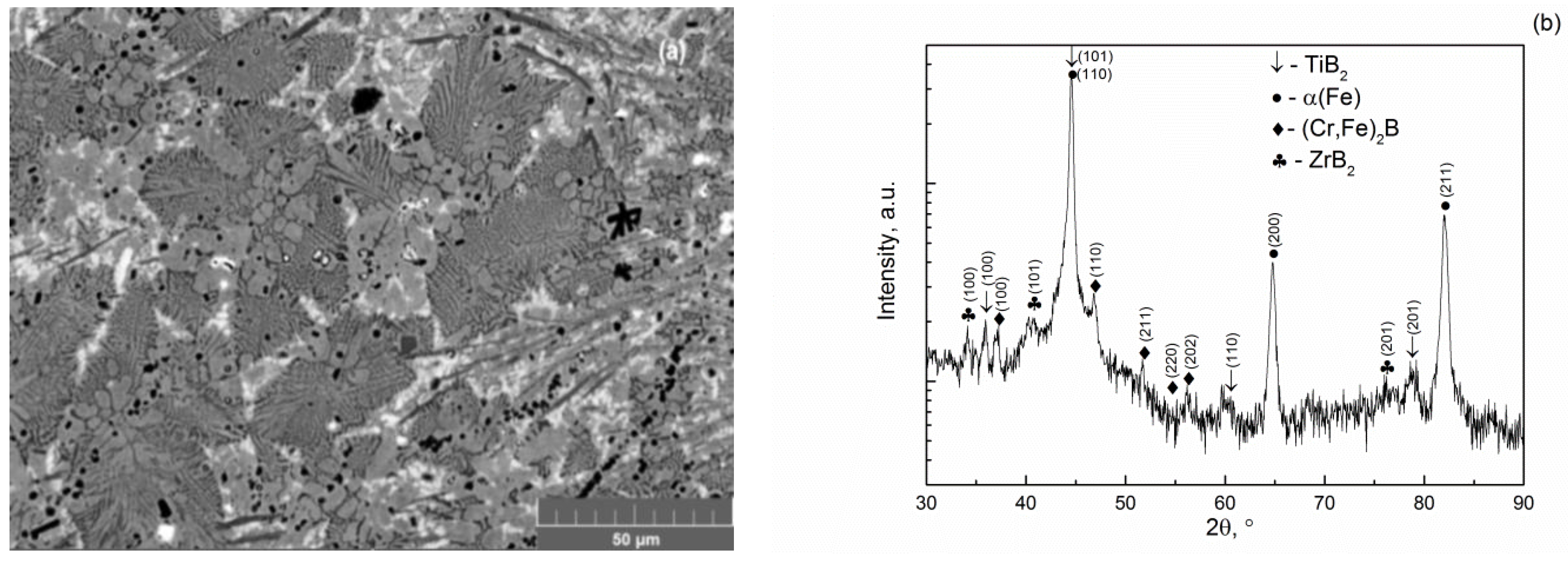
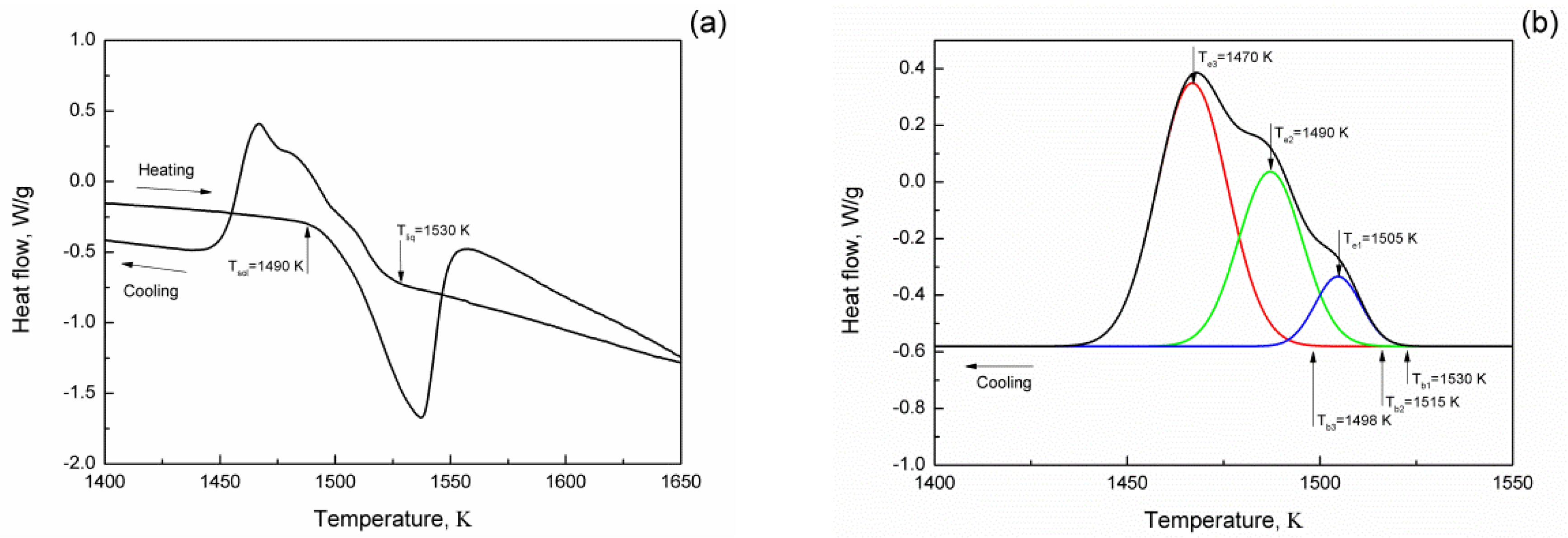

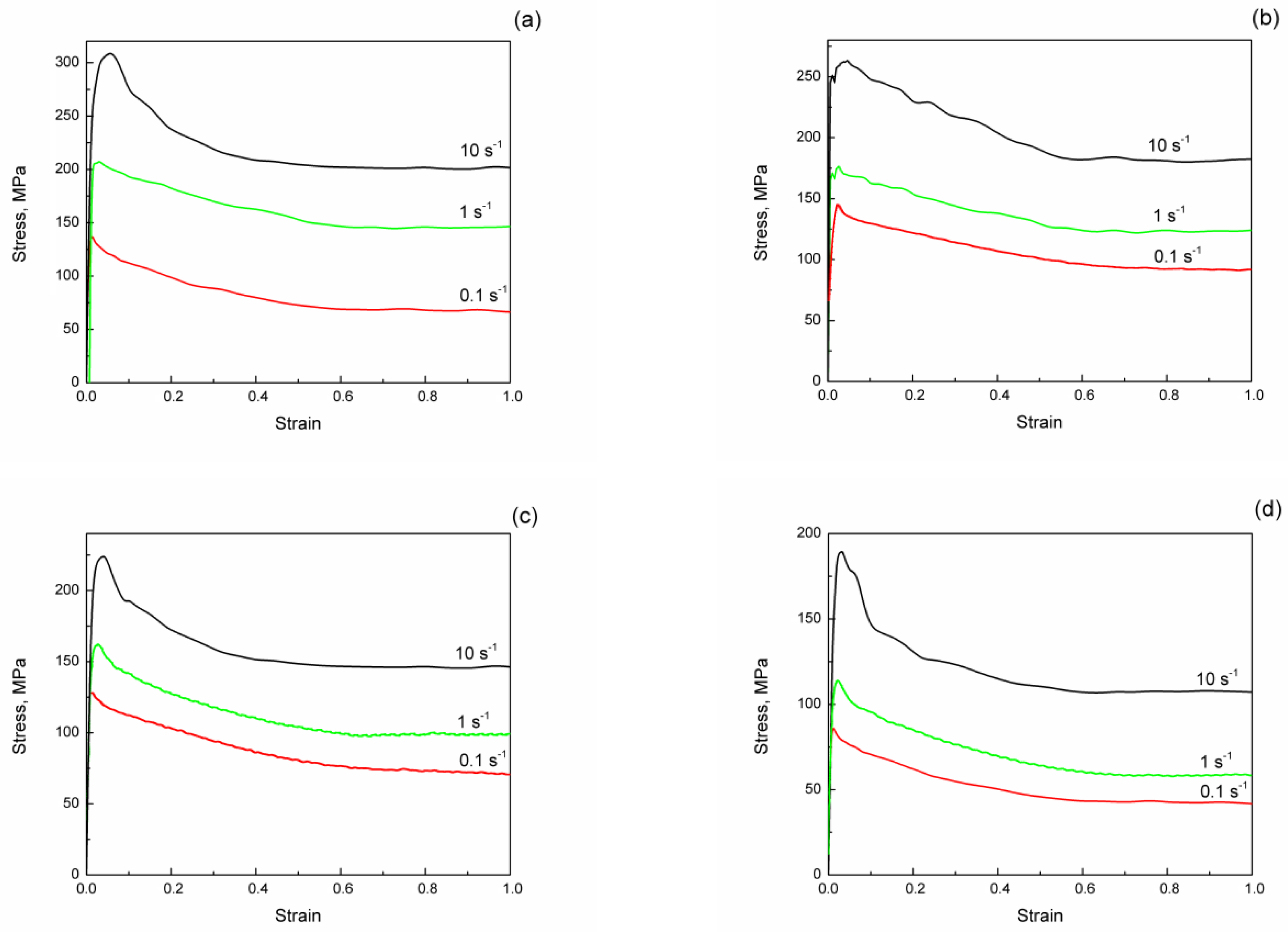
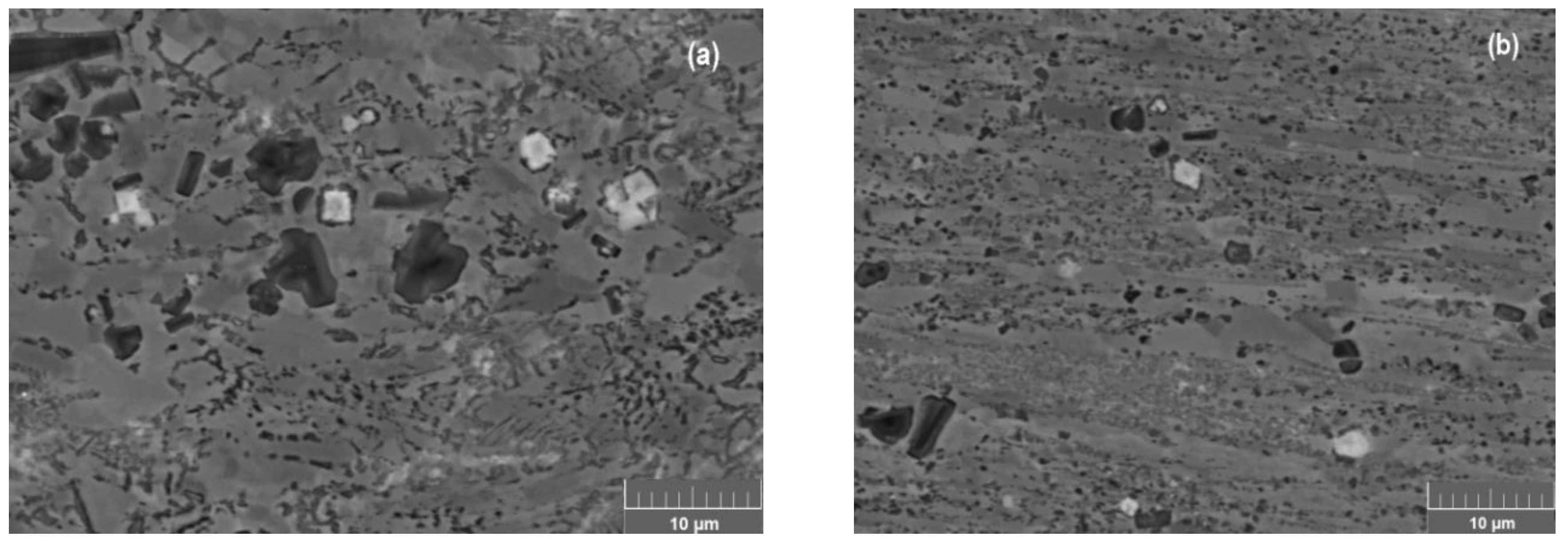
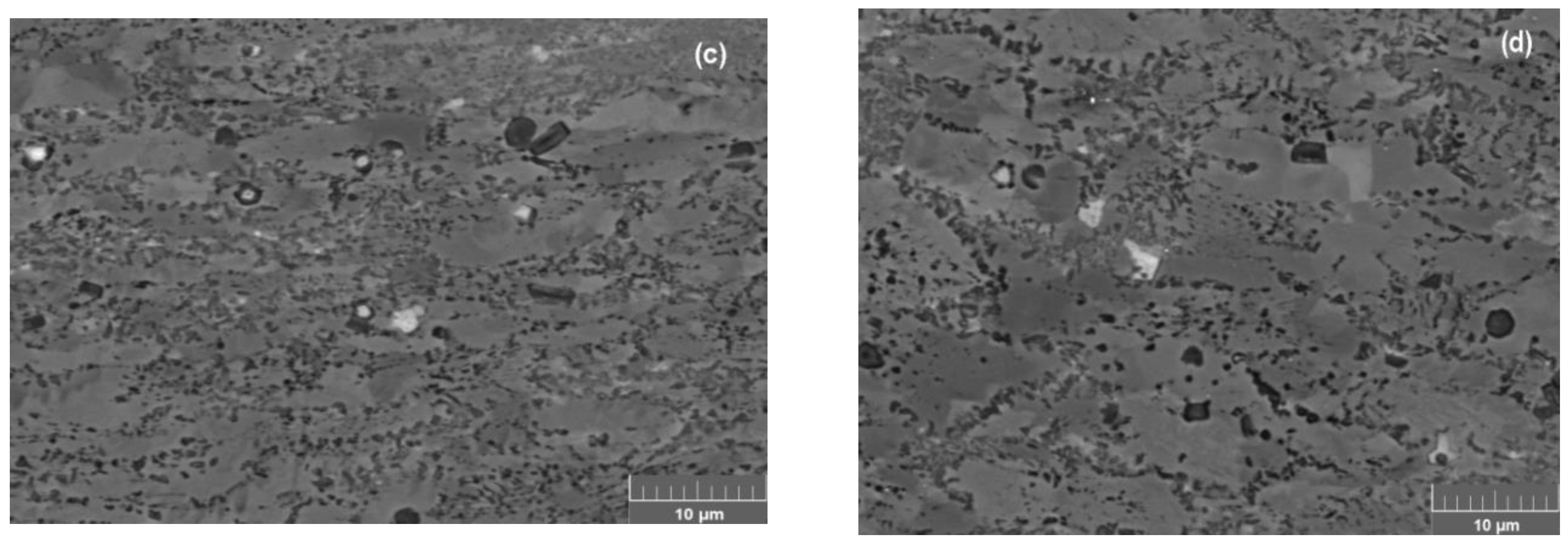

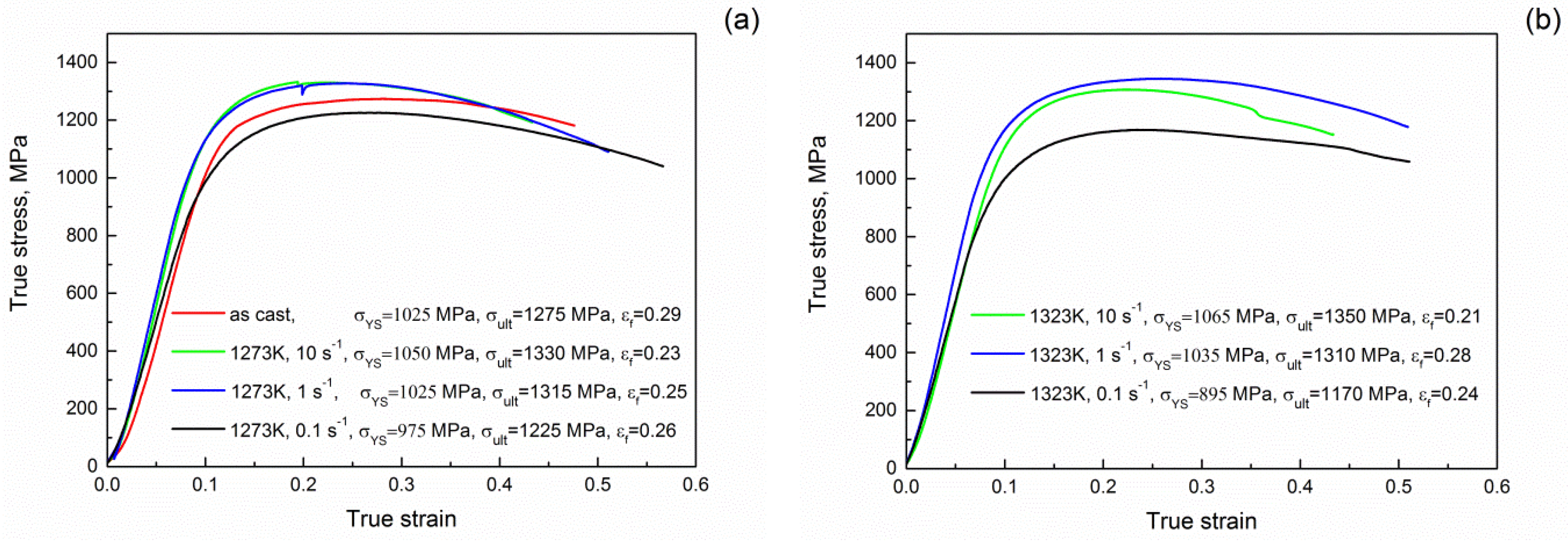
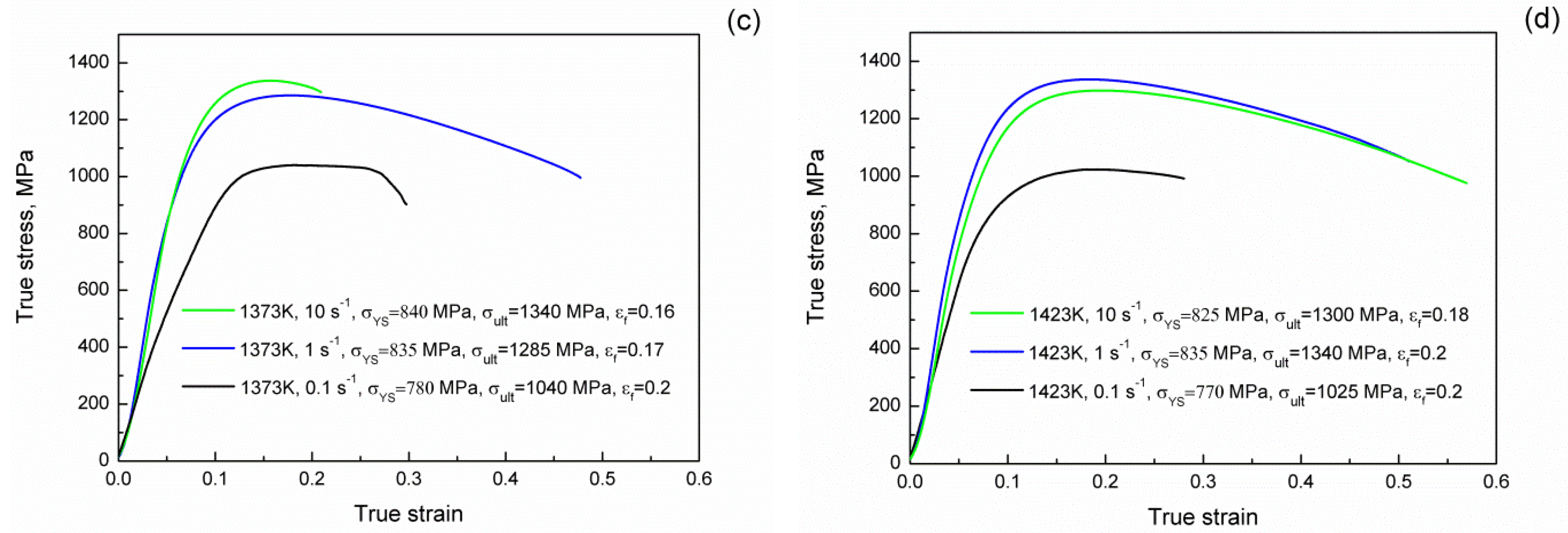

| State | Average Size of the Particles, μm | ||
|---|---|---|---|
| TiB2 | (Cr,Fe)2B | ZrB2 | |
| As-cast | 3 ± 1 | 0.7 ± 0.2 | 2 ± 0.6 |
| HD 1373 K, 1 s−1 | 2 ± 0.5 | 0.5 ± 0.1 | 1.8 ± 0.6 |
| HD 1373 K, 10 s−1 | 1.5 ± 0.5 | 0.4 ± 0.1 | 1.4 ± 0.4 |
| HD 1423 K, 1 s−1 | 1.2 ± 0.3 | 0.5 ± 0.1 | 1 ± 0.3 |
| HD 1423 K, 10 s−1 | 1.1 ± 0.3 | 0.6 ± 0.1 | 1 ± 0.2 |
© 2019 by the authors. Licensee MDPI, Basel, Switzerland. This article is an open access article distributed under the terms and conditions of the Creative Commons Attribution (CC BY) license (http://creativecommons.org/licenses/by/4.0/).
Share and Cite
Prosviryakov, A.; Mondoloni, B.; Churyumov, A.; Pozdniakov, A. Microstructure and Hot Deformation Behaviour of a Novel Zr-Alloyed High-Boron Steel. Metals 2019, 9, 218. https://doi.org/10.3390/met9020218
Prosviryakov A, Mondoloni B, Churyumov A, Pozdniakov A. Microstructure and Hot Deformation Behaviour of a Novel Zr-Alloyed High-Boron Steel. Metals. 2019; 9(2):218. https://doi.org/10.3390/met9020218
Chicago/Turabian StyleProsviryakov, Alexey, Baptiste Mondoloni, Alexander Churyumov, and Andrey Pozdniakov. 2019. "Microstructure and Hot Deformation Behaviour of a Novel Zr-Alloyed High-Boron Steel" Metals 9, no. 2: 218. https://doi.org/10.3390/met9020218
APA StyleProsviryakov, A., Mondoloni, B., Churyumov, A., & Pozdniakov, A. (2019). Microstructure and Hot Deformation Behaviour of a Novel Zr-Alloyed High-Boron Steel. Metals, 9(2), 218. https://doi.org/10.3390/met9020218







